 |
| |
 |
| January 12, 2021 |
| Tech to expect (and not) in 2021 |
|
Plus: A simpler weather website, unified multi-room music, and the case of the missing privacy labels
|
| |
 |
|
It's strange to be writing this email to you all from the comfort of my own home.
Normally around this time of the year, I'd be scrambling around Las Vegas, trying to get a sense of what's next in technology at the annual CES trade show. In the past, I've enjoyed turning those findings into a newsletter that tries to spot some upcoming trends.
But in 2021, CES is an all-remote event, one that's quieter than usual with major players like Amazon and Google bailing out. Instead of being able to poke and prod at the latest tech inventions, I'm stuck sifting through a pile of press releases and blog posts. I miss being at the show—even if I'm not missing the sleep depravation and energy bar diet that goes with it—and hope that an in-person version becomes feasible in 2022.
Nonetheless, I'm still going to try and push on with annual tradition and offer some predictions for the year ahead:
8K, like it or not: I got a chuckle out of TCL's announcement of new Roku TVs for 2021, particularly the line that says all of its top-shelf 6-Series TVs will support 8K resolution. 8K content remains practically nonexistent, and even with TCL promising "intelligent upscaling" for lower-resolution video, most people can barely tell the difference from 4K, even on huge screens. While I don't suggest seeking out 8K if you're buying a new TV, it might just become unavoidable, especially in higher-end sets.
Mini LED materializes: As for TV tech you can get excited about, mini LED is becoming much more prevalent in 2021. Although TCL seemed to have a lock on the technology before, it's being joined this year by Samsung and LG, which will brand their mini LED sets as "Neo QLED" and "QNED," respectively. (Vizio, which hasn't made any CES announcements, seems likely to produce mini LED TVs as well.) Compared to conventional LED sets, Mini LED backlighting is much more granular, allowing for contrast and black levels that rival OLED TVs at lower prices. Just don't confuse the tech with Micro LED, which is even more impressive but could cost tens of thousands of dollars when it hits the market.
HDMI 2.1 arrives (again): Also noteworthy is the greater number of TVs supporting HDMI 2.1, including Sony's "XR" series Bravias, LG's OLED TVs, and select TCL sets. (It's also showing up in some high-end computer monitors.) Although the standard has been kicking around for a couple years now, it's finally worth seeking out for gaming on the new PlayStation 5 and Xbox Series X consoles, which both support HDMI 2.1's new features. Pairing those systems or a nice gaming PC with a compatible TV will make controller input more responsive, reduce screen tearing effects, and allow for higher framerates even at 4K resolution.
Wi-Fi 6E still seems distant: CES brought a few more murmurs about Wi-Fi 6E after its big announcement last April, but nothing that makes me think you should rush to upgrade your router right away. The new standard, which adds a third high-speed band alongside the current 2.4 GHz and 5 GHz ones, will start showing up in routers this year, albeit at sky-high prices. Linksys' mesh Wi-Fi system starts at $450 for a single access point, while Netgear's first Wi-Fi 6E router will cost $600. You'll also need Wi-Fi 6E phones, computers, and streaming players to take advantage of the standard, and those will only start to arrive later in the year. This is looking like 2022 tech for all but the most bleeding-edge adopters.
Monitors get smarter: I wouldn't call it a trend yet, but Dell's forthcoming video conference monitors could be harbingers of more feature-packed desktop displays to come, especially if remote work becomes a permanent way of life. They'll have built-in buttons for joining Microsoft Teams meetings (ugh), but also pop-up webcams with noise-cancelling microphones and infrared sensors for signing into Windows with face recognition. Somewhat related: Lenovo's all-in-one PC that rotates into portrait mode and the smart TV-like monitor that Samsung announced last fall.
|
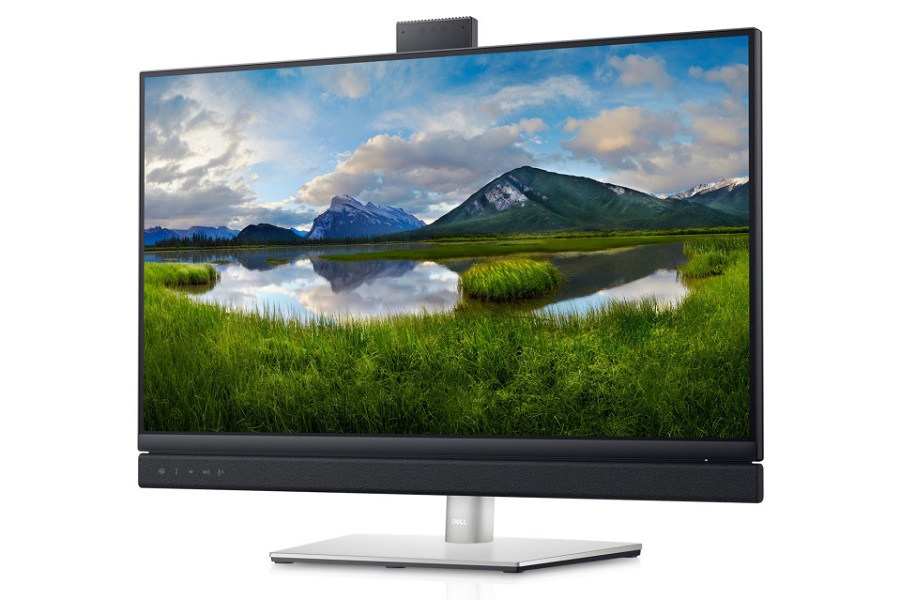 |
|
Laptops get taller: Back in June, I wrote a story for PCWorld wishing for more laptops with screen resolutions in between 1080p and 4K, so that users wouldn't have to choose between a pixelated picture and terrible battery life. At the time, PC makers told me we'd start seeing more laptops hit the sweet spot as they abandon the 16:9 widescreen aspect ratio used by most TVs. We're starting to see that happen at CES, as vendors announce more laptops with taller 16:10 or 3:2 aspect ratios at lower-than-4K resolutions, including Lenovo Thinkpads, Lenovo IdeaPads, LG Grams, and HP Elites. If you're still in the market for a new laptop this year, the decision between sharpness and battery life might not be so agonizing.
A long wait for "rollables": While we're still waiting for foldable phones to become more affordable, both LG and TCL showed off phones with displays that roll out to become larger, and LG says it will ship its tech in an actual product this year. The idea feels like exactly where foldable display tech was a couple years ago, in that a year or two crude, expensive products will go by before most of us would even think about buying them ourselves. I still love these concepts, of course, but they do lose some of their luster when you can't see them up close.
A down year for smart homes: Smart home tech has been around long enough now to start feeling kind of dull, in the sense that we all know what to expect. The ecosystems of Amazon Alexa, Google Home, and Apple HomeKit are well-established, as are the tentpole use cases of smart lighting, home audio, and security. The subdued nature of this year's CES—normally a big show for smart home tech—isn't doing much to change the dynamic. There are plenty of one-off gimmicks, from experiential baths to robot butlers, but I can't point to any industry-shifting trends, even if we can all probably get behind the idea of cheaper smart toilets.
|
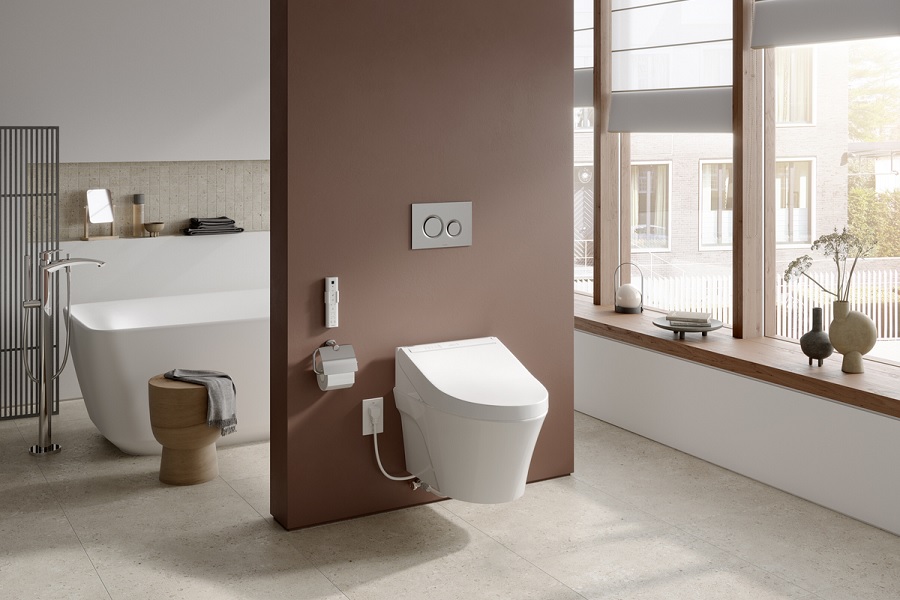 |
|
With that, I'm ready to flush CES 2021 down the drain. Here's to the promise of running ragged through Vegas a year from now.
|
 |
|
Thanks to those of you who filled out my Advisorator reader survey last week! If you haven't done so yet, please take a couple minutes to respond and help me shape the future of this newsletter. I'll pick one respondent at random this Friday, January 15, to receive a $50 Amazon gift card. (You can also forgo the gift card drawing and fill out the survey anonymously.)
|
 |
| Need to know |
|
Roku's wireless soundbar push: Back in late 2018, Roku released a pair of wireless speakers that worked exclusively with Roku smart TVs. The idea was to simplify the pairing process and eliminate wires running between the speakers and the TV set. Now, Roku's extending the concept to third-party soundbars, starting with TCL's Alto R1. The soundbar connects wirelessly to any Roku TV, pairs through an on-screen menu, and offers convenient audio control through the TV remote.
It's a neat idea, but one that comes with a couple catches. Since the soundbar doesn't work with other televisions, you're effectively locked into using Roku TVs unless you swap sound systems. And unlike with Roku's own wired soundbars, these wireless ones can't be turned into a surround sound system with satellite speakers. (Roku tells me that they can be paired with a subwoofer, however.) Roku's forays into home audio are still worth watching, but I also get the sense that it's still putting all the pieces together. (See also: My newsletter on what to look for in a soundbar.)
Mint's big upgrade: About a year ago, Rob Pegoraro wrote a great story about the decline of Mint, a once-beloved personal finance service that fell into disrepair after it was acquired by Intuit in 2009. That story was apparently a wake-up call, as Intuit has just rejuvenated its iPhone app with a slick design and new features, such as automatic subscription tracking. (An equivalent overhaul for Android should arrive in about a month.) Pegoraro has a new story with all the details.
The upgrade probably wasn't just the result of his reporting, though. Mint is also under pressure from newer competitors like You Need a Budget, Quicken's Simplifi, and Monarch, not to mention the budget-tracking features of Apple's credit card. While Mint has the advantage of being free—at the expense of mining users' data for targeted ads—it probably couldn't afford to let its apps languish for much longer.
The case of the missing privacy labels: Speaking of overdue software updates, my FastCo colleague Michael Grothaus has astutely pointed out that Google's iOS apps haven't been updated since December 7, the day before Apple started requiring developers to submit "privacy labels" with their App Store listings. As I wrote in last week's newsletter, those labels tell you what kinds of data each app collects and how they use that data to track you.
Grothaus rightfully wonders whether Google is stalling to avoid the bad press Facebook received when it updated its apps last month, but the search giant isn't the only one dragging its feet. Other major companies, including Amazon and Pinterest, haven't updated their apps since the privacy label requirement took effect either.
Of course, these companies can't avoid updating their apps forever, but they're clearly not hurrying to figure out what level of disclosure they can get away with. Keep that in mind if you're trying to look up the labels for your apps.
|
 |
| Tip of the moment |
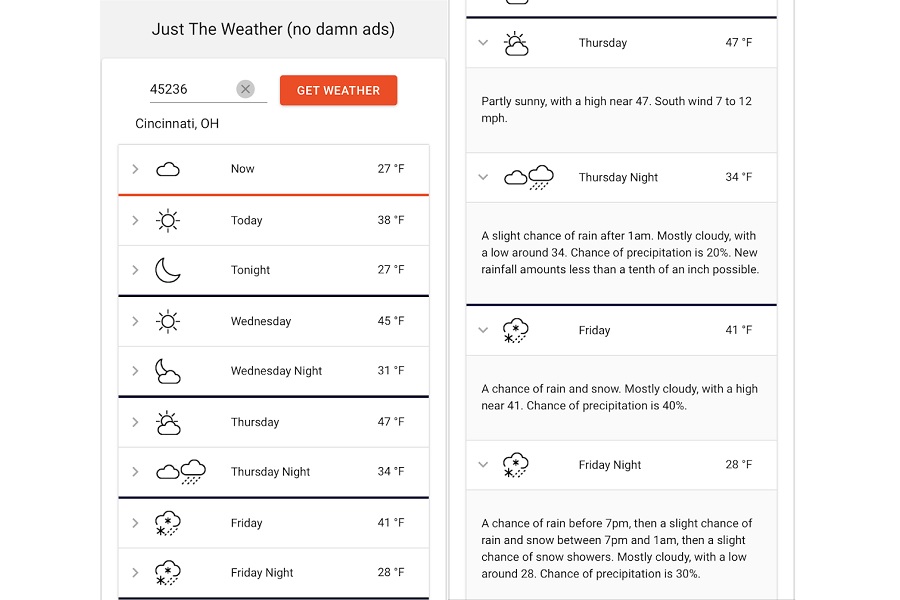 |
|
A simpler weather website: This week's quick tip is a little different than usual, in that I can guarantee you haven't seen it elsewhere. Just the Weather is a free weather website made by a close friend of mine, Adam Tracey, and it's essentially the faster, mobile-friendly version of weather.gov that I've always wanted.
While most weather apps overwhelm you with information, Just the Weather presents you with a simple readout of weather conditions, temperatures and wind speeds for the next seven days. Data comes from the National Weather Service—in fact, the forecast descriptions are identical to what you'd find on weather.gov—and as the site's tagline suggests, there are no ads to contend with.
One notable quirk, though: The site is only available at www.justtheweather.app, with the "www" being required. But once you've visited the site and entered your zip code, you can bookmark the address with your zip code embedded, or add the site to your home screen for faster access.
(Also, for the sake of disclosure: Adam made this website primarily for himself and his friends, but gave me permission to mention it here. I wouldn't recommend it if I didn't find it genuinely useful. Thanks, Adam!)
|
 |
| Now try this |
|
Unified multi-room music: If you're like me, you've probably amassed a decent number of audio devices that aren't meant to talk with one another, from Sonos and Google Home speakers to soundbars equipped with Apple AirPlay. Thanks to longtime Advisorator subscriber Tim W., I'm now tuned into an Android app called AirMusic that joins all of these audio systems together.
When you launch AirMusic, it will automatically detect Sonos, Google Home, Samsung Multiroom, AllPlay, Heos, AirPlay, and DLNA devices, and you can optionally enable streaming to Fire TV and Roku players as well. The app can then record any audio playing on your phone and re-stream it to all those devices at the same time. (If you have a rooted Android device, this recording step is not necessary.)
|
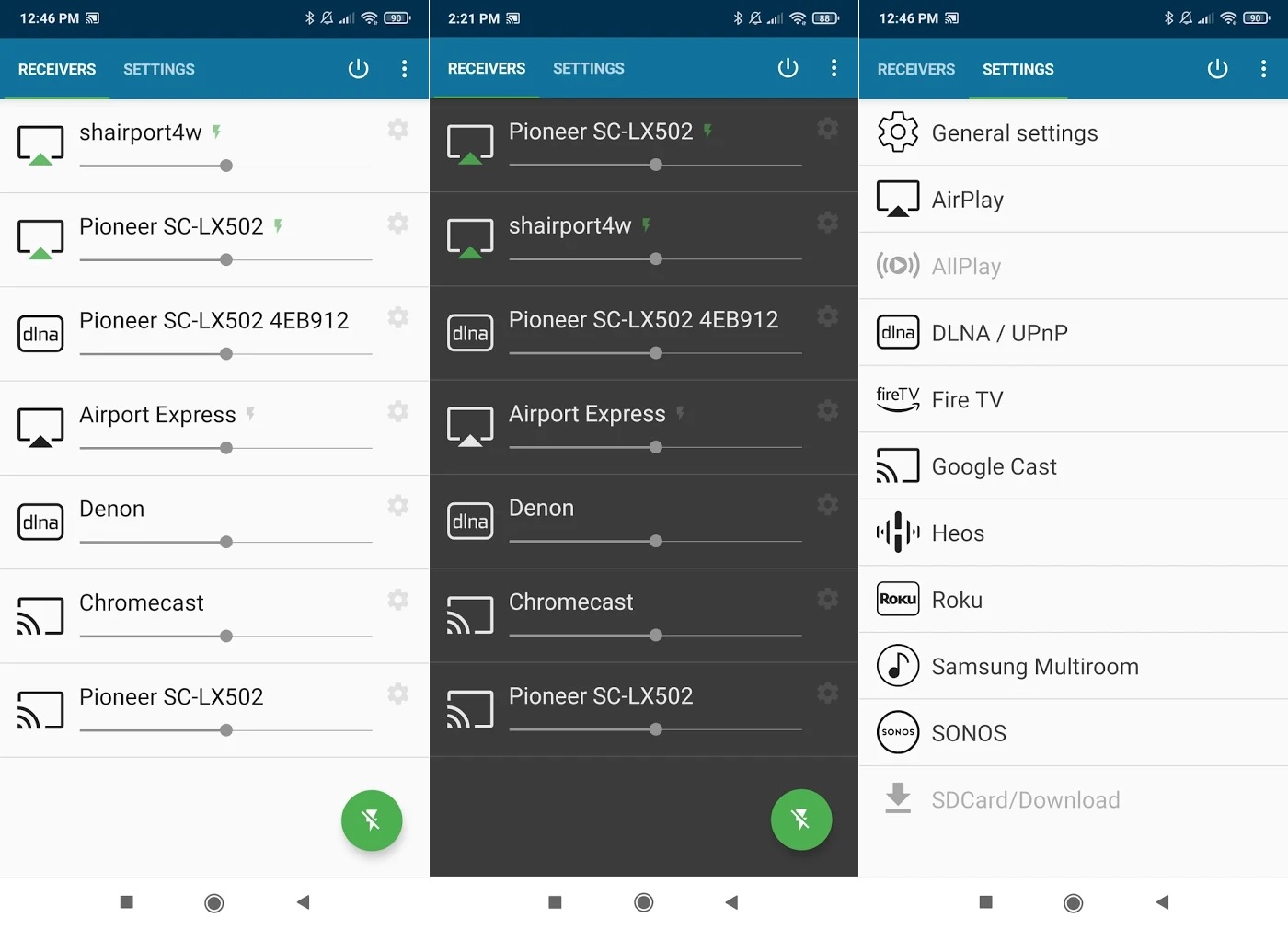 |
|
Some aspects of AirMusic aren't exactly user-friendly. You have to enable the audio capture in AirMusic's settings menu or else you'll get a scary warning about microphone feedback, and you'll likely have to add some audio delay to certain speakers for them to play in sync. But once the app was set up, it worked quite well for me.
To use AirMusic, you'll need a phone running at least Android 10 (or, alternatively, a rooted device), and you can try it out with up to 10 minutes of free audio playback before it starts incessantly beeping. After that, you can pay $4.49 to use AirMusic without restriction. Thanks for the tip, Tim!
|
 |
| Around the web |
|
|
 |
| Spend wisely |
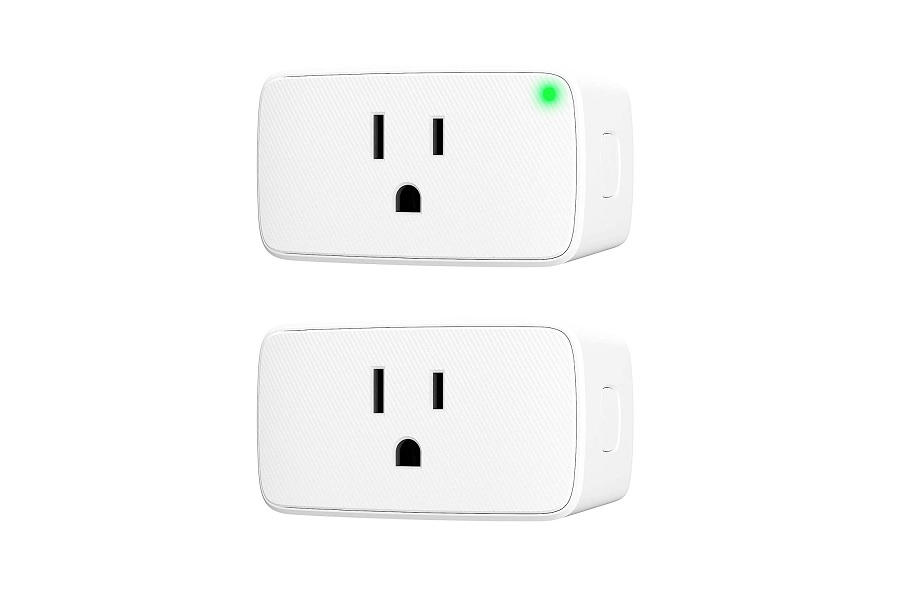 |
|
Smart plugs that support Apple's HomeKit almost always cost a bit more than their non-HomeKit counterparts, but this deal on a pair of VOCOlinc plugs brings them closer to price parity. You can get two for $21 total from Amazon when you clip the on-page coupon, allowing you to automate lamps, humidifiers, or anything else that turns on with outlet power, either with HomeKit routines or Siri voice commands. (A pair of TP-Link plugs without HomeKit support will currently cost you $4 less.)
Some other deals this morning:
|
 |
| Thanks for your support! |
|
Here again is one last reminder to fill out my Advisorator reader survey for a chance to win a $50 Amazon gift card. The feedback so far has been super helpful, and I could always use more of it!
Of course, I'm also happy to answer your tech questions over email or in Advisorator's chat room on Slack.
Until next week,
Jared
|
 |
|
|
 |
|






